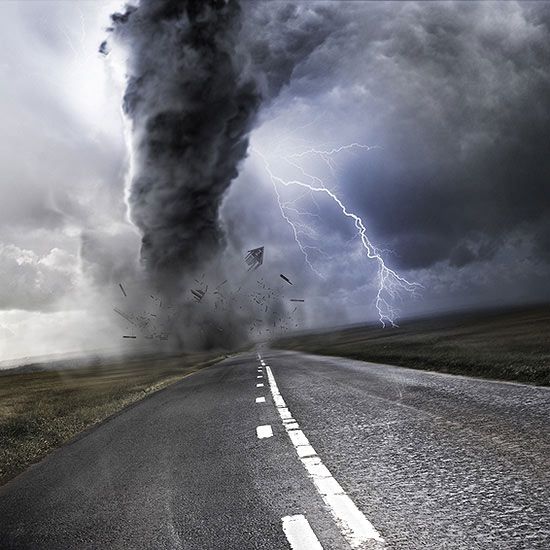Preparing Kids for Natural Disasters
Calm your child's fears about hurricanes, earthquakes, and other disasters with these steps.
Within the past year, natural disasters like the California wildfires, Floridian tropical storms, and now the midwestern tornadoes have made huge headlines. Although you probably try to keep your children away from the news when events like these happen, they are bound to hear about it and start to worry. Taking steps to prepare kids for natural disasters can help reduce their anxiety when severe weather occurs in your area.
Give the Facts
Depending on your child's age, he might know that hurricanes and tornadoes can cause serious damage and hurt people, but he may not understand what actually happens during these events or what causes them. Don't worry -- you don't have to sit him down for a two-hour meteorology lesson. But parents should start by teaching kids about two types of disasters that could affect the home: an evacuation emergency, such as a fire, and a shelter-in-place emergency, such as a tornado, says Paul Purcell, author of Disaster Prep 101. The fire emergency is a smart starting point for the discussion because both natural disasters and non-weather-related issues can cause fire. Choose the other emergency by determining which is likely to occur in your area. Once you feel your child is ready, you can teach him about other natural disasters.
If you're unsure about how to explain disasters, the Federal Emergency Management Agency (FEMA) has a parent- and kid-friendly site with information on each disaster's cause. Reading books such as I'll Know What to Do: A Kid's Guide to Natural Disasters and I Wonder Why Volcanoes Blow Their Tops: and Other Questions About Natural Disasters may also be helpful.
Offer Comfort
It's natural for kids to be fearful of these events. Obviously, you should try to reassure your child, but don't say there's no reason to be afraid or that the disaster won't happen in your area. This can sound dismissive of your child's feelings, and it's not good to make promises about situations you can't control. Instead, let her know it's okay to be scared; then be honest about the situation."Even for kids as young as age 5, you could say, 'Sometimes these things do happen. It's very rare, but not impossible. Here's what we will do to get through it,'" says Kate Roberts, Ph.D., a clinical psychologist specializing in school psychology.
Create a Family Disaster Plan
Gather your kids and, along with your partner, explain the importance of preparation. Talk about which disasters your family is most at risk for, how to prepare for each danger, and how to respond if it occurs. Then create an evacuation plan that includes two outside meeting places in case your family members are separated. One spot should be right outside your home, maybe near the mailbox. The other should be outside the neighborhood -- at the library, for instance, or in front of the police station -- in case you can't return home. You also need a shelter-in-place plan. Choose a room with the fewest windows and doors to designate as the safe room.
Another important part of disaster preparedness is communication. In an easily accessible place, keep a list of emergency services numbers and the cell phone, school, and work numbers for all household members. Try using FEMA's downloadable Family Emergency Plan as a guideline.
Other considerations during emergency planning can be the care of pets, how to turn off utilities, and the disaster plans of your child's school and your workplace.
Prepare a Disaster Kit
No disaster plan is complete without supplies. Allow your child to help you gather the gear; this will reassure him that you really are prepared, and he will feel good about doing his part to protect the family.
Your kit should include: nonperishable foods, water, a battery-powered radio, flashlights, extra batteries, a manual can opener, cash, copies of personal identification, matches, a cell phone and charger, and an extra set of keys. Depending on your family's needs, you may also need diapers, formula, prescription medications, and other essentials.
Purcell recommends adding your child's favorite snacks as well as a couple of coloring books or other small hobbies he enjoys. Making the day after the disaster as much like the day before the disaster helps kids have a sense of normalcy during a distressing time, Purcell says.
Do Disaster Drills
Just as your child practices fire drills at school, disaster drills at home are a good way to review what to do during a crisis. First, model the drill for your children and then have them participate. Depending on which drill you're practicing, you want to teach your kids how to warn others of the danger, how to escape from the home, where to meet after escaping, where to "shelter" inside the home, how to contact emergency personnel, and what steps to take after the incident. Practice drills regularly and as your kids get the hang of them, pick up speed to simulate the sense of urgency during a true emergency.
Monitor Exposure to Media Coverage
Whether there's a hurricane warning for your city or a different part of the world just experienced a tsunami, be aware of what your child sees on TV or in other media."Much of media coverage is visual, and these images are for adult brains and very difficult to get out of a child's mind," Dr. Roberts says. Plus, when kids see multiple reports of the same event, they may think it's happening repeatedly. If your child sees or hears coverage that causes her to worry, answer any questions and remind her that if it ever happens in your area, you have a plan in place.
Groups.io Links:
You receive all messages sent to this group.
View/Reply Online (#32311) | Reply To Group | Reply To Sender | Mute This Topic | New Topic
Your Subscription | Contact Group Owner | Unsubscribe [volcanomadness1@gmail.com]


No comments:
Post a Comment